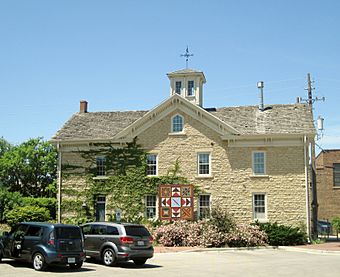Lemuel Milk Carriage House facts for kids
Quick facts for kids |
|
|
Lemuel Milk Carriage House
|
|
 |
|
| Location | 165 N. Indiana Ave., Kankakee, Illinois |
|---|---|
| Area | less than one acre |
| Built | c. 1865 |
| Architectural style | Italianate |
| NRHP reference No. | 79000849 |
| Added to NRHP | June 4, 1979 |
The Lemuel Milk Carriage House, also called the Stone Barn, is a historic building in Kankakee, Illinois, United States. It is the last remaining part of a huge property. This land once belonged to Lemuel Milk, who owned over 25,000 acres!
Contents
The Story of the Stone Barn
Who Was Lemuel Milk?
Lemuel Milk moved to Kankakee, Illinois from New York around 1855. He was one of the first people to settle in this area. Milk helped to drain the wet, swampy land around Kankakee. This made the land good for farming.
By buying cheap, wet land and draining it, Milk built a huge property. It was more than 25,000 acres. This made him one of the biggest landowners in all of Illinois. Milk also opened a department store in Chebanse in 1868. He ran this store until 1883. In 1876, he started the Waldron Ice Company. This company collected ice from the nearby Kankakee River. Milk also served on the board of a hospital in Kankakee.
What Was the Carriage House Used For?
The carriage house was built sometime between 1861 and 1868. It is the only building left from Milk's large estate. Lemuel Milk lived in a big seventeen-room mansion. That mansion was located at Oak and Indiana Avenues, but it has since been torn down.
Besides keeping his carriage safe, Milk also used this building to house his farm animals. Today, the carriage house is the third-oldest building still standing in Kankakee. Only the First Baptist Church and the Asbury United Methodist Church Sanctuary are older.
Later Uses of the Building
The building was used as a barn until the early 1920s. After that, it became a garage for painting cars. Later, it was used as a warehouse for a hardware store owned by Fred Swannell Sr.
In 1973, the building was changed into a bakery and restaurant. However, the restaurant did not stay open for long. After that, the building became a place where local community groups could meet. On June 4, 1979, the carriage house was officially recognized. It was added to the National Register of Historic Places by the National Park Service.
Building Design
The carriage house is built using limestone found right in the local area. The roof has a small, decorative tower called a cupola. On top of the cupola is a weather vane. This cupola is placed where the two parts of the roof meet.
The building does not have many decorations. It mostly has a wide, bracketed cornice. A cornice is a decorative molding along the top of a wall or building. Inside, you can still see the rough wooden beams that support the roof. These are called roof trusses. The floor was changed to concrete in the 1920s.



